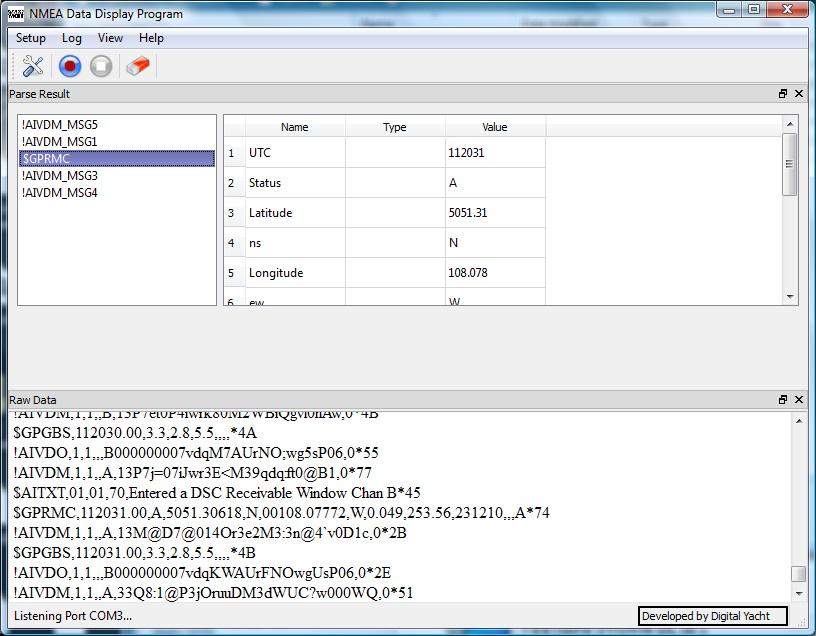NMEA 0183 has become the most widely adopted standard for data communication in the Marine industry. Based on the old RS232 Serial Interface used on computer terminals data is transmitted as a series of high and low voltages between two pieces of wire. Although fairly simple in principle, NMEA 0183 interfacing causes a great deal of confusion for customers and hopefully this article will give some basic advice for fixing simple connection problems.
1) Electrical Connection
NMEA Outputs can drive 2 or 3 devices so connecting a GPS to a DSC VHF and a Chart Plotter is possible, but you must only ever connect one NMEA output “Talker” to an NMEA input “Listener”. For example, you cannot have the output of the GPS and the output of an Instrument System connected to the same input of a chart plotter.
You must always connect two wires for successful data transfer a +wire and a -wire. As long as you get the Output+ connection to the Input+ and the Output- connection to the Input- everything should be fine. Some manufacturers refer to the + connection as “A” and the negative connection as “B” but this is not that common these days. Some systems will have a common negative connection for the Input and Output in which case you take the Output- and Input- wires from the equipment you wish to connect and wire them both to the Common Negative connection.
Finally, if a piece of equipment just has a single wire Output+ but the equipment you are connecting to has a 2 wire input, take the Input- connection to the negative (0 volt) supply of the boat.
NMEA data can sometimes be measured with an electrical meter set to DC Volts, but the readings can be misleading and it is far better to test NMEA data with a Light Emitting Diode (LED) available for a few pence from electronic shops. Please read our Tech Note on how to use an LED to test NMEA data.
2) NMEA Data Speeds
Originally there was just one “flavour” of NMEA 0183 data, with all of the systems transmitting data at 4800 Baud (bits per second). When AIS systems came along it was clear that to cope with the amount of data output by an AIS receiver or transponder, that NMEA 0183 data would have to get faster. A new “flavour” of NMEA 0183 was introduced – NMEA 0183HS where HS stands for “High Speed” which operates at 38400 baud. As a general rule, all AIS systems work at this faster 38400 baud, whilst all other systems on the boat operate at 4800 baud, with a few exceptions such as NMEA Multiplexers that work at 38400 baud.
You cannot connect a 38400 baud output to a 4800 baud input and vice versa and when connecting to equipment that can have different baud rates, particularly chart plotters it is always best to check that they are set to the right baud rate for the equipment connected to them. Another important note, is that on most systems the Input and Output ports are paired so you cannot have NMEA Output 1 of a chart plotter operating at 4800 baud and NMEA Input 1 at 38400 baud.
3) NMEA Data Sentences
NMEA 0183 data is transmitted in bursts, where each burst is referred to as a “Sentence”. There are lots of different NMEA Sentences, one or more for each type of data transmitted i.e. Depth, Wind, Position, etc. Detailed Specifications of the data structure of NMEA 0183 Sentences are available from the NMEA Organisation, although there are many on-line articles that will give a good basic understanding.
In order to “look at” this data, technicians traditionally used a terminal program to display the data on a computer. In early versions of Windows, Microsoft included a program called Hyper Terminal which was very good for reading NMEA 0183 data but when Windows Vista was released, Hyper Terminal was no longer included, so Digital Yacht created a free NMEA Display Program to help our dealers and customers read NMEA 0183 data. Fully Windows 7 compatible, this NMEA display program not only displays the raw data but also formats and parses the data in to a more understandable format, so that you can actually read the values of depth, wind, position, etc.
A screen shot is shown below and to download the complimentary fully functional program (with no adverts or malware !!) please click here….







Dear Sir, Can I download the NMEA display program? Thanks and best.
Dear Jerome,
We’ve updated the link. Try again and the link will work.